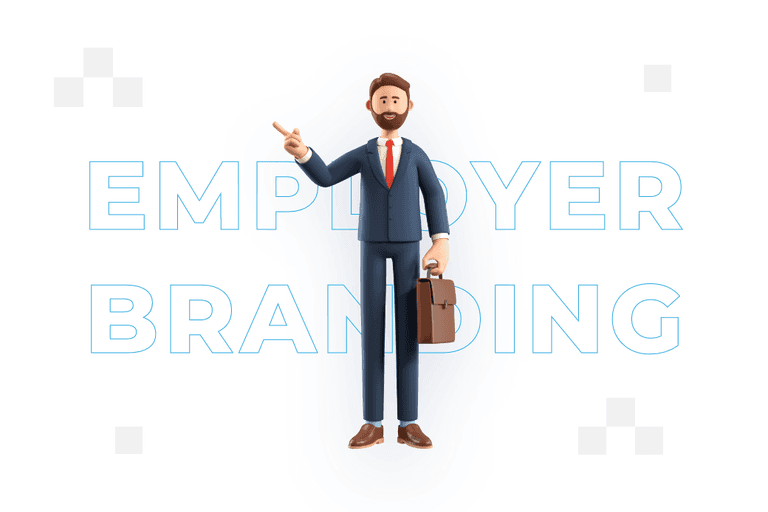
Employer branding – what it is and what it consists of?

Today’s companies are courting employees not only with money, but also with many other measures such as flexible working hours or free lunches. These often form part of an extensive employer branding strategy. What is employer branding and what benefits can it bring to your brand?
Employer branding – definition
The origin of the term ’employer branding’ dates back to the 1990s. It was first used by Simon Barrow and Tim Ambler in a 1996 article published in the Journal of Brand Management.[1]. They described the concept of employer branding as “a package of functional, economic and psychological benefits associated with employment and offered by a given employer in its relationship with employees”. It was recognised then that this approach to managing a company’s brand would attract, engage and retain the best employees.
Today, employer branding can be understood as the process of building a company’s image as an attractive employer. Its essence is to promote the organisation as a place offering a friendly working environment, competitive salaries, favourable employment conditions and opportunities for professional development. The main aim of this activity is to attract and retain talented employees.
In the age of digitalisation and globalisation, the importance of employer branding is growing. Organisations are competing in the labour market not only locally, but also internationally. Effective employer branding strategies can provide a competitive advantage by influencing a company’s ability to attract the best talent.
The implementation of an employer branding strategy encompasses a number of activities, such as communicating company values, creating attractive job offers or promoting company culture. Social media and other types of online marketing can be used for this. It is worth noting that effective employer branding is based on the authenticity and consistency of the message – the alignment of communication with the organisation’s actual values and practices.
Types of employer branding
Employer branding is usually divided into internal and external.
Internal employer branding – focuses on the company’s current employees. It is intended to build employee commitment and loyalty to the organisation. It uses methods such as training programmes, remuneration systems, employment policies or career development programmes. This type focuses on building the company’s image among current employees.
External employer branding – is aimed at potential employees, customers and investors. It should attract the best employees and increase the company’s attractiveness in the labour market. It uses advertising, websites or social media. It is more complex than internal and aims to build the company’s image among different audiences, including potential employees, customers, investors and the external community.
Benefits of employer branding
Employer branding can benefit both the company and the employees. In the first case, the undoubted benefit is the construction of a strong employer brand, which makes it possible to attract the best candidates for a job, so the company can build a strong team, reduce turnover and reduce recruitment costs.
It is also worth remembering that a company that invests in its corporate culture and offers attractive employee benefits can create a friendly and engaging working atmosphere, which has a positive impact on team morale and productivity.
The most general benefit of employer branding is to build your brand image. This can improve its perception in the local community and among customers, investors and other stakeholders. This can result in greater attractiveness and competitive advantage.
Employer branding also has many benefits for employees. Its activities result in better conditions, such as flexible working hours, remote working opportunities, training programmes, work-life balance policies and other additional benefits. This, in turn, can help employees to develop their skills, gain new experiences and advance to senior positions and increase their commitment to their work.
A good organisational culture in a company in which the organisation focuses on work-life balance can help employees to improve their quality of life. Employees who have more time for themselves and their families are more satisfied at work and less prone to job burnout. They also tend to be more loyal to the company and willing to represent the company’s image externally.
Creating an employer branding strategy
Creating an employer branding strategy is a long-term process and often requires the involvement of the entire organisation. It requires the knowledge, experience and commitment of managers and employees in all departments of your organisation. To create an effective strategy, it is worth bearing in mind factors such as:
Analysis of the company’s situation – The first step is to conduct an analysis of the company’s situation. It is worth examining in detail what the company’s goals and values are, the strengths and weaknesses, and the threats to the organisation. This approach will help define what the company wants to achieve and what it should focus on in employer branding. The analysis also provides an opportunity to pre-define the resources (by this we mean both tools and budget) needed to accomplish the tasks.
Defining the target group – As part of employer branding, it is worth defining exactly who your company wants to reach. It is worth defining the groups of employees you want to attract to the company, as well as identifying the competencies and skills required for the position.
Designate a team – An employer branding strategy covers the whole company, but a specialised project team is usually responsible for its implementation. This should include staff from multiple departments – the greater the scope of their expertise, the better they will be able to tailor specific activities and objectives to your brand requirements.
Create a consistent image – A consistent image is a key element of employer branding. It includes, but is not limited to, consistent communication, the use of consistent colours and logos, and ensuring that every element associated with the company is consistent with its mission and values. It is worth paying attention to how your company presents itself on different levels, what values it promotes and what it wants to achieve. The image consists not only of the graphic layer, but also of the content published by your brand.
Investing in employees
Companies that focus on the development of their employees and have an attractive Employee Value Proposition – offering training, career development programmes, flexible working hours, as well as private medical care or insurance – attract the best talent and increase their commitment to the organisation. To successfully implement an employer branding strategy, investment in employee training can be essential. Employees will improve their knowledge and can better understand the purpose of the organisation’s activities.
Regular monitoring of the effects of activities
It is a good idea to measure the effects of implemented activities, e.g. the number of visits to the website, the number of candidates for a specific position, as well as the level of employee satisfaction. This will allow you to assess which activities bring the best results and adjust your strategy.
Best practices in employer branding
Best practices are activities that allow companies to attract the best talent and build a positive image as an employer. The most common distinctions are:
- Creating a positive organisational culture – a key element of employer branding. The company should be guided by specific values that form the foundation of its operations and communicate them clearly to employees.
- Flexible working hours – one of the practices that allow companies to attract the best candidates and retain existing employees. Employees value the ability to adapt their working hours to their lifestyle.
- Clarity in communication – a company should clearly and precisely communicate what it offers employees and what it expects from them. This makes employees feel more engaged and motivated to perform.
- Friendly working atmosphere – an organisation that cares about the working atmosphere builds a positive image as an attractive employer. As a result, employees feel more motivated to perform and are more loyal to the organisation.
- Promoting a sustainable lifestyle – a practice that is gaining popularity among employees. It can take care of employees and the environment. Not only can this attract the best talent and build a positive brand image, but it can also reduce, for example, electricity costs.
Limitations of employer branding
Although employer branding is an effective strategy, it has some limitations. Its implementation comes at a high cost, which can be difficult for a company to bear. Good practices, such as investing in employee development or flexible working hours, can be costly and resource-intensive.
Employer branding is a process that requires time and patience. Companies expecting immediate results may be disappointed when they do not see the expected results in a short period of time. It is also important to remember consistency in action. Lack of consistency in action can lead to a negative image as an employer. The need to maintain consistency in actions can be time-consuming and require a great deal of discipline throughout the organisation.
It should not be forgotten that sometimes it is difficult to change an image. Companies that have neglected their reputation as an employer need to take many steps to build a positive image. This process can be difficult and requires the commitment of the whole organisation. Besides, employer branding is the brand promise that a company makes to its employees. Employees who choose to join an organisation may be disappointed if the reality does not meet their expectations.
Companies not only offer specific products or services, but also create messages for their customers and potential audiences. They also often communicate with others (both companies and customers), so they may require a defined brand communication strategy, a social media plan or content marketing. These and other elements go into employer branding to maintain a consistent image of your brand. This, in turn, can translate into improving its market position and increasing interest in your brand.
Contact form
Develop your brand
Rate content:
You may be interested in:




